Building a kayak rack for your RV can seem daunting, but it doesn’t have to be. In this comprehensive guide, we will break down the process step by step and provide you with all the information you need to make an informed decision. We’ll go over the different types of racks available, what materials you’ll need, and how to put it all together. So whether you’re a first-time builder or a seasoned pro, read on for some helpful tips!
Table of Contents
Is It Possible to Carry a Kayak on the RV?
RVs are great for a number of reasons. They offer a ton of versatility, whether you’re looking to take a cross-country road trip or simply camp in your own backyard. RVs also come in all shapes and sizes, so there’s sure to be one that’s perfect for you. And, if you’re looking to add a little extra excitement to your RVing experience, why not build a kayak rack?
Yes, you can easily carry a kayak on the RV. It is possible to mount the racks onto the roof or on the side of an RV.
There are many different ways that people have created their own personal designs for carrying kayaks on RVs. But, we will show you some of the most popular and common methods that people use to transport their kayaks.
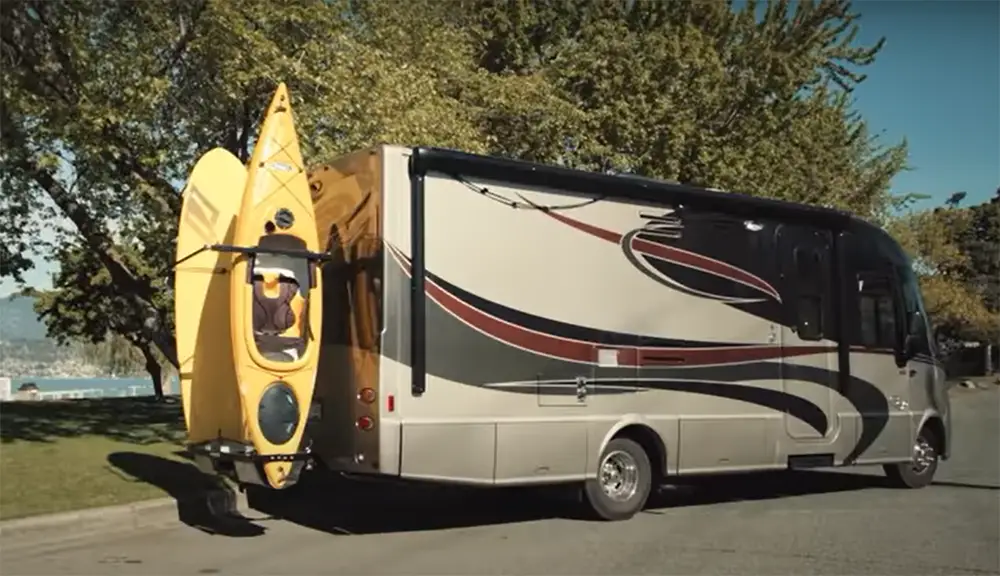
Another common reason people choose to carry kayaks on their RVs is because it allows them to explore more of the waterways near their campsite. If you’re camping near a river or lake, having a kayak with you means that you can go for a paddle whenever you want. Plus, it provides a great workout. Paddling is a great upper body workout, and if you’re camping in a remote location, you may not have any other way to get your exercise.
You don’t have to worry about finding a place to rent one or getting there and back before the rental place closes. Plus, it’s much cheaper in the long run to own your own kayak than it is to keep renting one every time you want to go paddling.
Why Would You Opt-in For DIY Kayak Rack?
A kayak rack is a great way to transport your kayaks, and it can also double as storage for other gear like bikes or camping equipment. What’s more, it’s a relatively easy project that anyone can do with just a few tools and some basic knowledge of carpentry. There are also some more benefits to building a rack by yourself.
Cost-Effectiveness
One of the main reasons people choose to build their own kayak rack is because it’s much more cost-effective than buying a pre-made one. If you’re handy and have some basic carpentry skills, you can easily build your own rack for a fraction of the cost of buying one.
Customization options
Another advantage of building your own is that you can customize it to perfectly fit your RV. You can add as many or as few features as you want, and you don’t have to worry about whether or not the rack will fit your RV properly. Your kayak needs to be securely mounted to not move around while you’re driving.
Lastly, it’s a great way to show off your handyman (or woman) skills to all of your friends!
Are Roof Kayak Racks or Back Kayak Racks Better?
Now that we’ve gone over some of the reasons you might want to carry a kayak on your RV, let’s talk about the best way to do it. There are two main methods for carrying kayaks on RVs – roof racks and back racks.
Roof racks
Roof racks are the most popular method for carrying kayaks on RVs. They’re often cheaper and easier to install than back racks, and they don’t take up any space in your RV’s hitch.
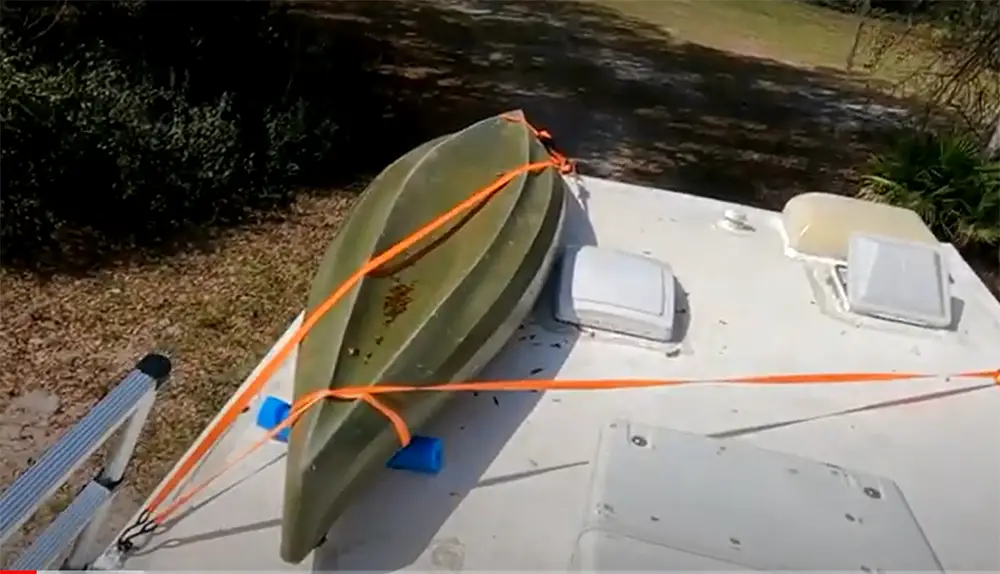
There are a few things to consider before you decide to go with a roof rack, though. First, you’ll need to make sure that your RV has enough clearance to accommodate a kayak on the roof. Second, you’ll need to be comfortable lifting the kayak onto the roof of your RV – if not, you may want to consider a back rack instead.
Back racks
Back racks are a great option if you don’t have enough clearance for a roof rack, or if you’re not comfortable lifting kayaks onto the roof of your RV. Back racks also have the advantage of keeping your kayak closer to the ground, which can be helpful if you’re worried about it being damaged by low-hanging branches or other obstacles.
The downside of back racks is that they may require a taller car to load your kayak, and they can take up valuable space inside your RV’s hitch when not in use.
Once you’ve decided which type of rack you want to use, it’s time to start planning your kayak rack. In the next section, we’ll show you the most common materials for a kayak rack. [2]
Material For the Kayak Rack
There are a few different options to choose from, but the most popular ones are wood, aluminum and PVC pipes.
PVC pipes
PVC pipes are a popular choice for kayak racks because they’re strong and lightweight. They’re also easy to work with and you can find them at most hardware stores.
PVC pipes also usually come with UV protection, which is important if you’re going to be storing your kayak outside.
Wood
Wood is surprisingly a common material used to build kayak racks. It is strong and durable, but it can be heavy and difficult to work with. If you choose to use wood, make sure you select a hardwood that is resistant to rot and insect damage. Cedar or redwood are good choices.
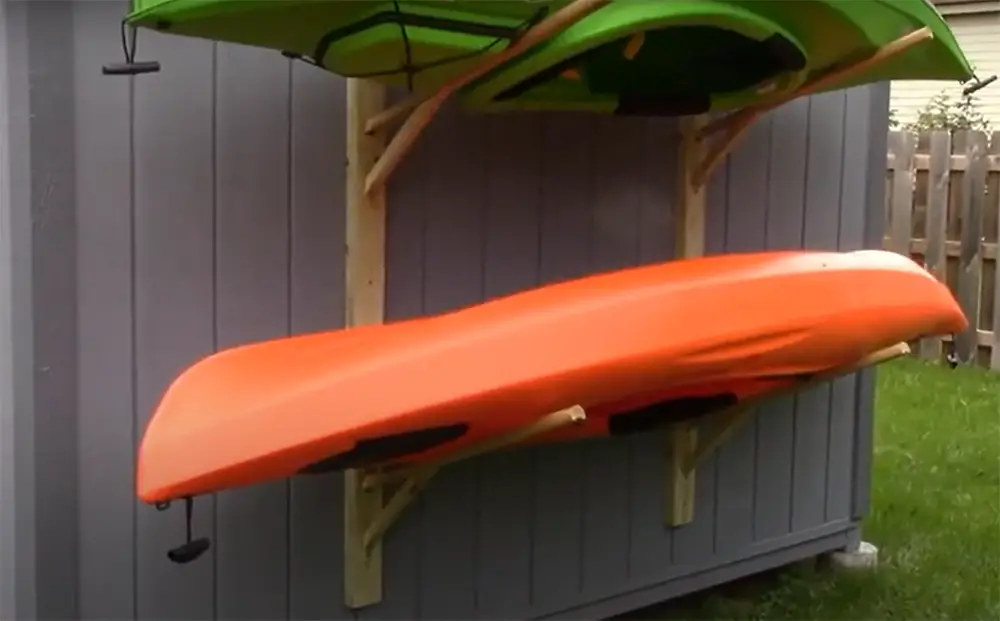
You will also need to seal the wood to protect it from the elements. Kayaks obviously are going to be exposed to a lot of water, so you need to make sure the wood won’t swell or rot. A good sealer will also protect the wood from UV damage.
One final thing to consider with wood is that it is not as easy to modify as some other materials. If you decide you want to change the design of your rack later on, it can be difficult to do with wood.
Aluminium
Aluminum is another popular choice for kayak racks. It is much lighter than wood, so it is easier to work with. It is also resistant to rust and corrosion, so it will last longer in harsh conditions.
The downside of aluminum is that it is not as strong as wood. It can bend or break if you put too much weight on it. It is also more expensive than wood.
If you choose to use aluminum, make sure you get a thick gauge so that it can support the weight of your kayaks. [3]
Building Your Own RV Kayak Rack
Measure your RV
The first step is to measure your RV. You need to know the length, width and height of the back of your rack in order to properly size the RV’s hitch. If you’re unsure of the dimensions, you can always ask a professional at your local RV dealership. They should be able to help you out. Once you have the dimensions of your hitch, you’re ready to proceed.
Get a pre-made hitch cargo carrier
A hitch cargo carrier is a great way to add extra storage space to your RV. They’re easy to install and can be used for a variety of purposes. In this case, we’re going to use it to build our kayak rack.
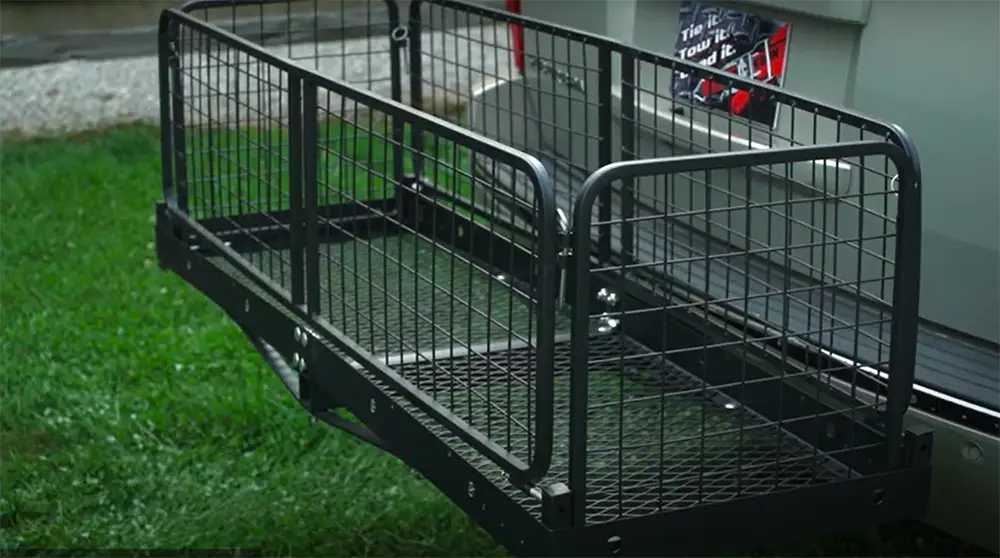
You can find hitch cargo carriers at most automotive stores or online. Make sure you get one that is the right size for your RV. Consider the weight capacity and the size of your kayaks when choosing a career as well. [3], [4], [5], [6]
Assemble the carrier
Once you have the carrier, it’s time to assemble it and attach to your RV’s back hitch. This is usually a simple process that just requires following the instructions that come with the carrier. Most carriers will come with all of the necessary hardware, but you may need some tools to get the job done. A drill and a socket set are usually all you need. [4], [5], [6]
Strap the empty milk crates to the carrier
You can also go for a much cheaper method. Strapping milk crates to your RV for example will serve as a decent alternative. Why milk crates? They’re the perfect size for kayaks and they’re strong enough to support the weight. You can find them at most supermarkets or you can order them online.
Make custom sized holes in them so that the ends of kayaks can fit snugly inside. Next, strap them down securely with ratchet straps or rope. You don’t want your kayaks falling off while you’re driving!
This can be done with a variety of methods, but we recommend using ratchet straps. They’re easy to use and will keep your kayaks secure. Just make sure that the straps are tight enough so that the crates don’t move around, but not so tight that they damage the kayaks. [4], [5], [6]
Pad the milk crates with foam
Now that the milk crates are strapped to the carrier, it’s time to pad them with foam. This will protect your kayaks from bumps and scrapes while you’re driving. You can find foam padding at most hardware stores or online. Cut it to size and glue or tape it in place. Make sure that the foam isn’t too thick so that it prevents the crate lid from closing properly.
And that makes a fine back rack for your RV! Now, let’s move to the DIY roof rack project. [4], [5], [6]
Building a Roof Kayak Rack for Your RV
There are a few things you’ll need to consider before getting started, but the main consideration is the type of roof you have. Let’s discuss if the roof rack is possible for your RV in particular.
Bare roofs
RVs with a bare roof are the most difficult to add a kayak rack to. That being said, it’s still possible and there are a few options available. The problem lies in the fact that bare roofs have no attachment points, which are the key to this project.
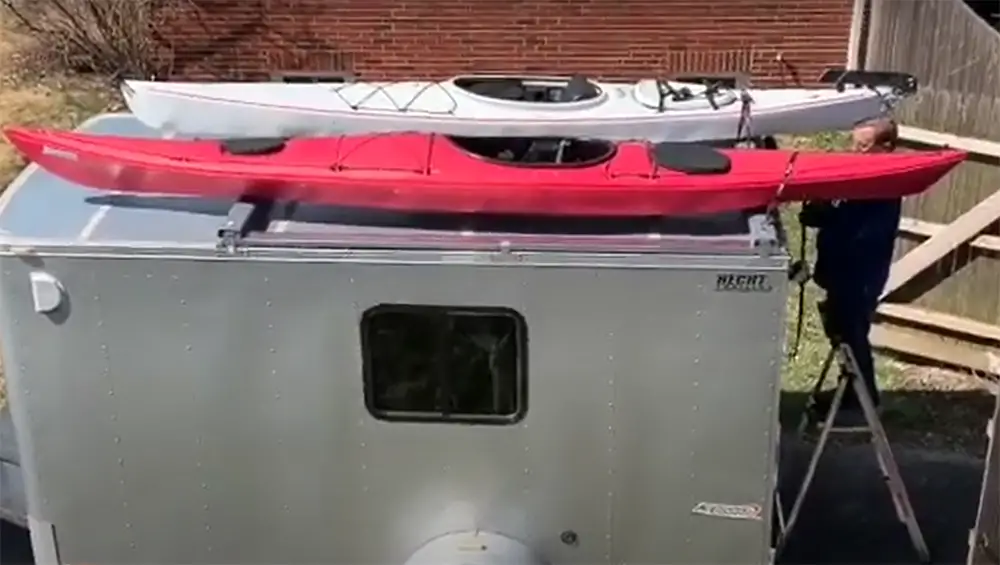
Side rail roofs
If your RV has a side rail roof, you’re in luck! This is the easiest type of roof to add a kayak rack to. You can simply attach the rack to the existing side rails using U-bolts and straps.
Side rails can either be raised or flush, but either way they provide a perfect place to attach your kayak rack.
Line roof rails with foam pool noodles
If you have roof rails, the process is relatively simple. You’ll just need to line the roof rails with foam pool noodles. This will protect your kayak from scratches and provide a little bit of cushioning in case of bumps.
If you need to, you can cut the pool noodles to meet the size of your rails. You’ll also want to make sure that the pool noodles are secure so they don’t move around while you’re driving. One way to do this is to tie them down with rope or bungee cords. No matter what you choose, you’ll want to be sure that the noodles are securely attached before proceeding.
Once the noodles are in place, you can simply place your kayak on top of them and tie it down. [1], [2], [4], [5], [6]
How to Transport a Kayak on Your RV Safely
Now that you have your kayak rack installed, it’s time to talk about how to transport your kayak safely.
Always strap the kayak down
J-bars
There are a few different ways you can strap down a kayak. The first is to use J-bars. J-bars are designed specifically for kayaks, and they provide a secure way to hold the kayak in place.
Ratchet straps
Ratchet straps are also good for securing a kayak to your RV. They’re easy to use and they’ll keep your kayak nice and snug against the side of your RV.
If you’re using ratchet straps, make sure to attach them to something solid on your RV. The last thing you want is for the strap to come loose and damage your RV!
Once you have the ratchet straps in place, give them a good tug to make sure they’re tight, but not too tight as they can easily be overtighened and damage the kayak. To prevent that, you can add any other padding or covers that you like. This will also help protect your kayak from scratches and bumps while you’re driving.
Bow and stern lines
In addition to strapping down the kayak, you’ll also want to secure it using bow and stern lines. These lines attach to the front and back of the kayak, and help keep it in place even if the straps come loose. This is also a good way to carry a kayak if your roof has no rails.
- Run the lines through the loops on the straps
- Tie them off at the front and back of the RV
Whatever you choose, just make sure it’s rated for the weight of your kayak (or two kayaks if you’re carrying more than one). And it’s always best to double check whether or not your kayak is fastened properly before hitting the road. [1]
Drive safely with kayak
Now that your kayak is safely secured to your RV, it’s time to hit the road! Just remember to take things slow and easy, especially if you’re not used to driving with a kayak. It’s always better to be safe than sorry.
Occasionally stop during your trip to check that everything is still secure. And when you reach your destination, be sure to give your kayak a good rinse off to remove any dirt or salt water.
Consider the distance between your car and the cars/environment around you. You don’t want it sticking out too far and hitting something (or someone!) while you’re driving. [1], [7]
FAQ
How do you carry a kayak on a truck camper?
The easiest way to do this is to purchase a kayak rack specifically designed to be mounted on the roof of your truck camper. These racks typically consist of two or more crossbars that attach to the camper’s roof, as well as some kind of system for securing the kayak(s) to the rack.
How do you attach a kayak to a trailer?
There are a few different ways that you can attach a kayak to a trailer. One common method is to use ratchet straps. You’ll want to loop the strap around the hull of the kayak and then through the J-style carrier before tightening it down. Another option is to use bungee cords. You can loop these around the kayak in a similar fashion as the ratchet straps, but they will provide a little bit more give and won’t be quite as tight.
What type of kayaks are best suited for an RV?
When considering which type of kayak to use on an RV, it’s important to take into account the size and weight of your vehicle. Smaller, lighter kayaks made from lightweight materials such as polyethylene or fiberglass are best suited for RV use because they are easy to transport and store. However, if you want a sturdier option that can handle rougher waters and longer trips, heavier models made from wood or composite materials may be more suitable.
How can you determine the amount of storage space you will need for your kayaks?
The amount of storage space you will need for your kayaks depends on the size and number of kayaks you plan to store. If you have one or two small fishing kayaks, a single 4-foot rack may be sufficient. However, if you have several longer touring or recreational kayaks, a wider 6-foot rack may be more suitable. Consider what type of overhead clearance is available on your RV when selecting the size and depth of the rack.
What are some materials that can be used to build a kayak rack for an RV?
Building a kayak rack for your RV can be an inexpensive and effective way to transport your kayaks. The basic components of a kayak rack will include some type of frame or platform, as well as straps or rope to secure the kayaks in place while they are being transported.
When choosing materials for your kayak rack, it is important to consider durability and cost. Steel is often the go-to choice for many DIY projects because it is relatively strong and affordable. However, aluminum is also another good option because it is lightweight yet still sturdy enough to hold up during transportation. Wood may also be used for framing but should not be used in direct contact with the water since it will eventually rot away after prolonged exposure.
How do you transport your kayaks when they are not in use?
If you’re a kayaker, then you know how important it is to have a safe and secure way of transporting your kayaks from one place to another. That’s why having a dedicated kayak rack for your RV can be so helpful! A kayak rack allows you to easily transport multiple kayaks at once without having to worry about them getting damaged in transit.
How much did it cost you to build your kayak rack?
The cost of the kayak rack will depend on the materials that you choose to use. Generally, it is not too expensive to build your own kayak rack and most of the costs will come from buying the materials needed to do so. You should be able to find all of the necessary supplies at a local hardware store or online. The total cost for building a kayak rack for an RV will vary, but typically it can range anywhere from $50-$100 depending on what type of wood or metal you use and how many hooks, straps, etc. you need.
What are the dimensions of a typical kayak?
The length of a typical kayak can vary, but the average size is between eight and ten feet in length. The width of a kayak typically ranges from two to three feet, depending on the model. It’s important to take note of the dimensions of your kayak before building a rack for it so that you know how much space you’ll need for it on your RV.
Do you need a roof rack to transport kayaks in an RV?
If you’re an RV owner who enjoys kayaking, investing in a roof rack for your vehicle is probably a wise decision. A good quality kayak rack can make all the difference when it comes to transporting your boats safely and securely.
How do you build a PVC kayak storage rack?
Building a PVC kayak storage rack for your RV is an easy and inexpensive way to store and transport your kayaks safely. With just some basic materials and tools, you can make a sturdy rack that will last for years. Here’s what you need:
- PVC pipes of various lengths (depending on size of the kayaks)
- PVC elbow joints
- PVC Tee joints
- PVC caps
- Hose clamps
- Screws
- Sandpaper
- Drill
- Saw
Begin by measuring the length and width of your kayaks so you know how long each PVC pipe should be. Cut the pipes to size using a saw and sand down any rough edges with sandpaper.
Next, firmly attach two PVC elbow joints to each end of the PVC pipes using hose clamps. Then, use T-joints to connect the vertical and horizontal pieces together at each corner. Cap off the open ends of all your pipes with PVC caps for extra security and strength.
Finally, mount your kayak rack onto your RV by drilling holes into it and inserting screws through the T-joints in order to secure them in place.
How do you build a 2×4 kayak rack?
Building a 2×4 kayak rack for an RV is a relatively simple project that can be completed in an afternoon. All you need are some basic tools and supplies, such as:
- 4 – 8 ft 2×4 boards
- Drill with bits
- 3/8” galvanized carriage bolts
- 1” galvanized washers and nuts
- Wood screws (optional)
Start by measuring and marking the boards at each end to create the desired length. Then cut the boards using a saw or jigsaw. Once all of your pieces are cut, use a drill to pre-drill holes in the wood where you will attach your hardware. Using the pre-drilled holes, attach the washers and nuts to the boards with your 3/8” bolts.
Next, lay out the four boards in a rectangle shape on the ground. Using wood screws (optional), attach each of the four ends together using two screws per joint. Finally, you can use additional hardware or straps to secure your kayak rack to the RV if desired.
Would you recommend others build a kayak rack for their RV?
Yes! Building a kayak rack for your RV is a great way to make the most of your space and have an easy place to store your kayaks. It’s also a relatively simple project that can be completed in just a few hours, depending on the design you choose. With the right materials and tools, it’s almost like having an extra storage area added onto your RV without having to buy or install something permanent. If you love spending time out on the water with your kayak, then investing in a custom rack for your vehicle is definitely worth considering.
Useful Video: How to build a DIY RV Kayak/Bike hitch rack
Conclusion
If you love kayaking, then a kayak rack is a must have addition to your RV. Kayak racks can be installed either on the top or on the back of your vehicle, and they provide a great way to transport your kayaks with ease. In this article, we have provided a comprehensive guide on how to build a kayak rack for your RV, for both roof and back transportation. We hope that you have found this information to be helpful, and that you will now be able to build a kayak rack of your own with ease! Thank you for reading and happy kayaking!
References:
- https://www.baysports.com.au/blogs/blog/how-to-transport-a-kayak
- https://rvingwithfamily.com/how-to-carry-kayaks-with-a-travel-trailer/
- https://www.kayakhelp.com/how-to-transport-a-kayak-on-a-small-car/
- https://boardandkayaklife.com/how-to-build-a-kayak-rack-for-easy-kayak-transport-on-an-rv/
- https://thefunoutdoors.com/rvs/how-to-build-a-kayak-rack-for-an-rv/
- https://www.kayakerguide.com/how-to-build-a-kayak-rack-for-an-rv/
- https://outdoorsoriented.com/blogs/news/16533772-why-we-hate-ratchet-straps

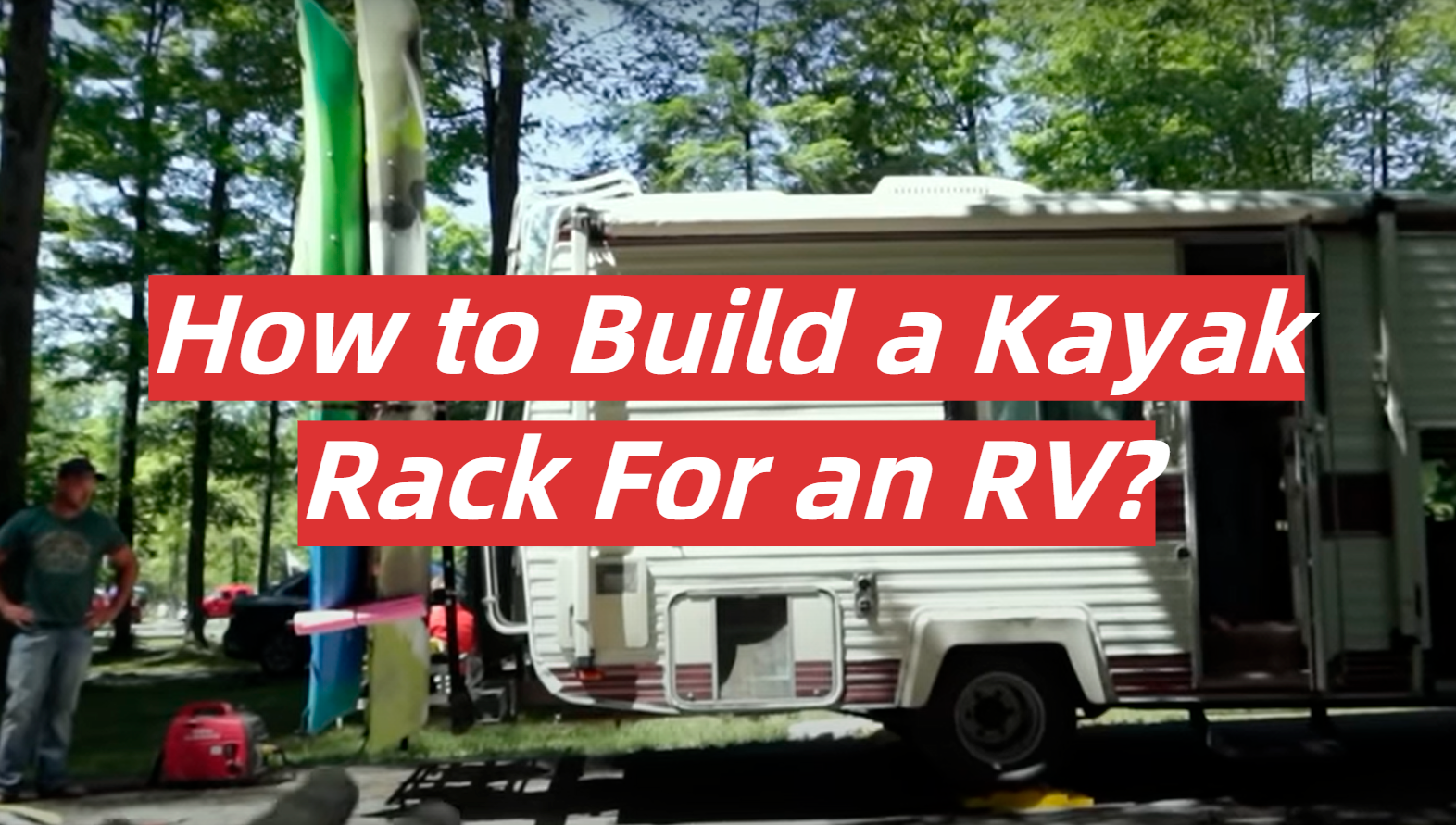
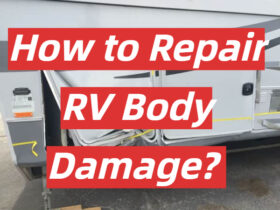
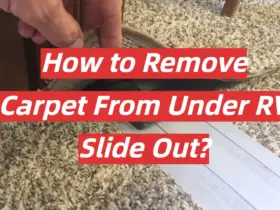
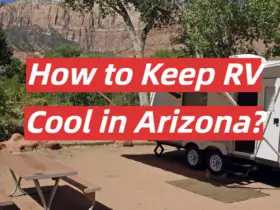
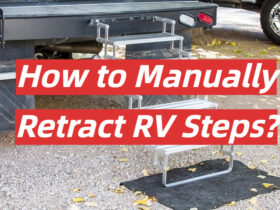
I have been kayaking for a few years now, and I absolutely love it. My wife and I enjoy spending weekends out on the water. When we bought our RV, we knew that we wanted to be able to bring our kayaks with us wherever we go. We searched online for a kayak rack for an RV, but we couldn’t find anything that suited our needs. So, we decided to build our own.
We started by measuring the width of our trailer. We then built two frames out of PVC pipe that were the same width as our trailer. We used T-joints and elbows to connect the PVC pipe, and we drilled holes in the frames so that we could attach them to our trailer with bungee cords. We then attached two hooks to the top of each frame, so that we could hang our kayaks from them.
It took us a few hours to build the kayak rack, but it was definitely worth it. It has allowed us to bring our kayaks with us wherever we go, and it has saved us a lot of money on storage fees. If you are looking for a way to transport your kayaks, I would definitely recommend building your own kayak rack for an RV.